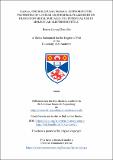Files in this item
Li@C₆₀, the molecular maraca : exploring the properties of lithium endohedral fullerenes on transition metal surfaces for potential use in molecular electronics
Item metadata
| dc.contributor.advisor | Schaub, Renald | |
| dc.contributor.author | Chandler, Henry James | |
| dc.coverage.spatial | xi, 177 p. | en_US |
| dc.date.accessioned | 2020-11-06T12:43:42Z | |
| dc.date.available | 2020-11-06T12:43:42Z | |
| dc.date.issued | 2020-12-01 | |
| dc.identifier.uri | https://hdl.handle.net/10023/20917 | |
| dc.description.abstract | The following thesis describes the exploration of lithium endohedral fullerenes (Li@C₆₀) on Au(111) and Cu(110)-(2×1)O utilising an ultra-high vacuum low temperature scanning tunnelling microscope (UHV LT-STM). In collaboration with researchers from the University of Edinburgh and the University of Liège, the effect of Li-encapsulation on the electronic structure of C₆₀ has been experimentally identified on single molecules for the first time, with particular attention to the superatom molecular orbitals (SAMOs). It was hypothesised these would stabilise due to the hybridisation of orbitals from the carbon cage and lithium. However, since the Li is known to stabilise in an off-centre position within the C₆₀, this asymmetry induces a non-degenerate stabilisation of the SAMOs. This stabilisation is analysed with scanning tunnelling spectroscopy (STS), and our conclusions are confirmed by photoelectron spectroscopy (PES) and time dependent density functional theory (TDDFT) data provided by our collaborators. Once the electronic structure is understood, the experiments detailed herein turn towards studying the Li@C₆₀ for potential as a multi-state single molecular switch. Upon identifying a set of parameters which allow the repeated, and reversible, manipulation of Li@C₆₀, the process is studied methodically and reveals that Li@C₆₀ can be switched between 14 distinct states. This is the highest number of discrete, accessible states to be observed on a single molecule switch to date. A mixture of scanning tunnelling microscopy (STM) and spectroscopy (STS) is required to identify these states, and high manipulation biases and tunnelling currents are needed to activate the switch. Since these parameters are orders of magnitude higher than those typically used, a new mechanism is required to describe the process. The suggestion made here is that resonant tunnelling electrons couple with the p[sub](x,y)-SAMOs to bypass the carbon cage thus activating the encapsulated Li and avoiding vibrational excitation of the C₆₀. Upon exciting the Li, it rattles around the interior of the fullerene before randomly stabilising in one of the identified 14 states. | en_US |
| dc.language.iso | en | en_US |
| dc.publisher | University of St Andrews | |
| dc.relation | Exploring the properties of lithium endohedral fullerenes on transition metal surfaces for potential use in molecular electronics (thesis data) Chandler, H.J., University of St Andrews. DOI: https://doi.org/10.17630/9c7a8aa4-c8b7-465a-837d-9665119e64cd | en |
| dc.relation.uri | https://doi.org/10.17630/9c7a8aa4-c8b7-465a-837d-9665119e64cd | |
| dc.rights | Creative Commons Attribution-NonCommercial-NoDerivatives 4.0 International | * |
| dc.rights.uri | http://creativecommons.org/licenses/by-nc-nd/4.0/ | * |
| dc.subject | Molecular electronics | en_US |
| dc.subject | Single molecule switch | en_US |
| dc.subject | Li@C60 | en_US |
| dc.subject | Lithium endohedral fullerene | en_US |
| dc.subject | C₆₀ | en_US |
| dc.subject | Scanning tunnelling spectroscopy (STS) | en_US |
| dc.subject | Low temperature ultra high vacuum scanning tunnelling microscopy (LT-UHV STM) | en_US |
| dc.subject | Single molecular manipulation | en_US |
| dc.subject.lcc | TK7874.8C52 | |
| dc.subject.lcsh | Molecular electronics--Materials | en |
| dc.subject.lcsh | Fullerenes | en |
| dc.subject.lcsh | Lithium | en |
| dc.title | Li@C₆₀, the molecular maraca : exploring the properties of lithium endohedral fullerenes on transition metal surfaces for potential use in molecular electronics | en_US |
| dc.type | Thesis | en_US |
| dc.contributor.sponsor | Engineering and Physical Sciences Research Council (EPSRC) | en_US |
| dc.type.qualificationlevel | Doctoral | en_US |
| dc.type.qualificationname | PhD Doctor of Philosophy | en_US |
| dc.publisher.institution | The University of St Andrews | en_US |
| dc.identifier.doi | https://doi.org/10.17630/10023-20917 | |
| dc.identifier.grantnumber | EP/M508214/1 | en_US |
The following licence files are associated with this item:
This item appears in the following Collection(s)
Except where otherwise noted within the work, this item's licence for re-use is described as Creative Commons Attribution-NonCommercial-NoDerivatives 4.0 International
Items in the St Andrews Research Repository are protected by copyright, with all rights reserved, unless otherwise indicated.


